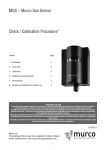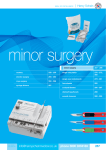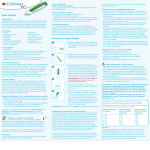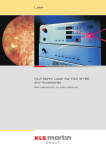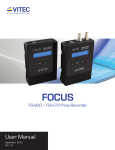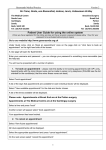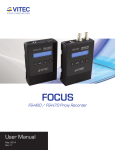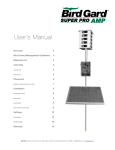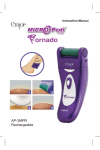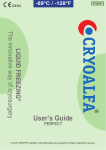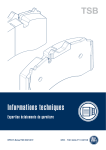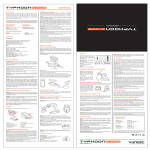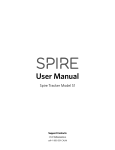Download Dermafreeze User Manual
Transcript
INSTRUCTIONS FOR USE Dermafreeze™ pack should arrive in good condition with all it contents. If this is not the case or if any items are missing from the pack or damaged you should contact us or your distributor before use. Dermafreeze™ is conveniently packaged in a lightweight portable self contained aerosol canister for ease of use, storage and portability. The aerosol canister is pressurized. Therefore protect it from sunlight and do not expose to temperatures exceeding 50°C. Do not pierce or burn, even after use. Do not spray on a naked flame or any incandescent material. Can cause cold burns. Keep out of reach of children. This aerosol is classified as NON-FLAMMABLE, is NON TOXIC TO THE ENVIRONMENT and DOES NOT CONTAIN CFC’s. GENERAL Dermafreeze™ is a liquid cryogen. Dermafreeze™ may only be supplied to Health Care Professionals as its use may result in damage to skin and underlying structures. By carefully following the instructions below, Dermafreeze™ may be used to safely and effectively treat a variety of skin conditions such as verrucae, warts, skin tags, papillomas and other benign superficial skin growths. The name given to this technique of treatment is ‘Cryosurgery’. ����������� ������ CRYOSURGERY - PRINCIPLE OF ACTION Cryosurgery has been used in medicine to treat a variety of conditions. The technique relies on the principle of thermodynamics and that of water expansion. Thermodynamics - when a liquid gas evaporates it takes heat from its surroundings causing a cooling or freezing effect. Water expansion - when applied to tissues (over 90% of living cells are made of water) a living cell is frozen and the following occurs; The cytoplasm (the liquid content of the cell) freezes and expands. The cell membrane also freezes and loses it elasticity. The expansion of cytoplasm causes damage or rupture of the cell membrane. This results in permanent damage to the living cells which may subsequently die. It is not the degree of freezing (so long as the tissue is frozen) but rather the rate at which the tissue freezes which causes the damage. Furthermore repeated cycles of freezing and thawing are more effective than one long period of freezing. This is because is alters the osmotic potential within the cell and results in fluid moving into the cell. This means that with each cycle of freezing more cell damage is initiated. This technique causes damage to the epidermis and to a lesser degree other underlying structures, such as the dermis. Epidermal cells are more sensitive to the effects of freezing than the underlying cells of the dermis. Melanocytes are also highly sensitive to the effects of freezing. CONTRA-INDICATIONS Cryosurgery MUST NOT BE APPLIED when a patient has cryoglobulinaemia. It should also be avoided; • If there is uncertainty regarding the diagnosis e.g. a possibility of a skin cancers. • If the area of skin to be treated is broken (such as a deep fissure/s) or open (such as an ulcerated site). • If the treatment area is near the ear ensure that the liquid cryogen does not enter the ear hole. For safety you should not treat the pinna of the ear and if treating an area close to the pinna, block the ear hole with a nonabsorbant material or a suitable ear plug. • If the area of the skin to be treated is close to the knuckles and other joint areas where there is only a thin layer of skin because there is a danger of damaging tendons and joint capsules. • When treating a patient who has a darker skin complexion. There is a risk of de-pigmentation and the patient should be made aware of this side effect. • Equally people with a lighter skin complexion may be left with a darkened area (blemish) of pigmentation after treatment. AFTER CARE Advise the patient that there may be discomfort, pain and redness during and after treatment. This is a result of reactive inflammation. Warn them that the area may blister. The blister may sometime fill with blood. The application of a soft padded dressing to the treated area will reduce any post treatment discomfort. Ask the patient to attend a follow up appointment so you can check the effects of treatment. If the condition has not resolved treatment should be repeated. Give the following written advice to patients; 1. Expect some pain after treatment. If necessary take pain-killers available from your local pharmacist to control pain. 2. Keep the treated area clean. 3. Bathing and swimming is permitted. 4. Do not pick at the area of treatment. 5. Do not to lance the blister, instead protect it with a plaster or small dressing. 6. Some conditions may require more than one treatment session. Therefore please ensure you attend any follow-up appointment you have. 1. THE CELL AT BODY TEMPERATURE: The cell is at its normal size, the cell membrane is elastic and the content is over 90% water (H20) 2. THE CELL DURING FREEZING STAGE: H2O Expands and stretches the cell membrane causing minor or major damage. 3. THE CELL DURING THAWING STAGE As H2O thaws its contracts into a liquid form again. However some of the H2O molecules form into crystals. The crystals raise the osmotic potential within the cell and more H2O moves into the cell. 4. THE CELL DURING A REPEATED FREEZING STAGE: H20 Expands and stretches an already damaged cell resulting in further damage and ultimate rupture and death of the cell. TREATMENT APPLICATION TECHNIQUES Before starting treatment, debridement (removal), of any excess callous or hard skin that has formed over warts, verrucae or lesion is recommended. This will maximize the freezing effect to the ‘active’ portion of the lesion(s). This will in turn increase the effectiveness and reduce the number of the treatments. This technique is painful, the extent of which will depend on the individual pain threshold of the patient. The consent, compliance and pain perception will improve by following a few basic principles. Be honest with the patient and ask them to expect a degree of pain. Offer them an idea of what will be involved during the treatment process, how many treatment visits will be required, the possible complications of treatment and how to look after the treated area(s) after treatment. CRYOFUNNEL™ The success of treatment depends on effective delivery of the cryogen to the active site of the treatment area. The cryogen used by Dermafreeze™ is a liquid gas which rapidly expands as soon as it leaves the aerosol container. So we have developed the NEW Cryofunnel™, which allows you to direct the spray precisely to the location of treatment with 3 sized circular openings of 5mm, 10mm and 15mm which will met the needs of most lesions. Furthermore this technique allows visualisation of the lesion during treatment so that you can monitor the progress. The technique is as follows: 1. Ensure the correct spray head attachment is on the aerosol canister. This is the one with the narrow spray spout. Refer to the diagram. 2. Place the Cryofunnel™ over the lesion using the chosen opening. 3. Hold the spray tip close to the Cryofunnel™ over the area of treatment. 4. Spray the liquid cryogen into the Cryofunnel™ opening until the treatment area becomes frozen white. This can be achieved by holding the spray for about 15 -30 seconds. 5. Positioning the patient so that the lesion is facing upwards to the ground level will ensure that this technique results in a shallow collection of liquid CRYOSPRAY This is an alternative method employed when treating an area which is larger than 15mm. It allows easier visualization of the effects of freezing. However in order to maintain the freeze the area should be sprayed continuously or periodically. The technique is as follows; 1. Ensure the correct spray head attachment is on the aerosol canister. This is the one with the narrow spray spout. Refer to the diagram. 2. Hold the nozzle/spray tip close to the area of treatment. cryogen inside the Cryofunnel™ over the area of treatment. This will enhance the freezing effect as the cryogen liquid will continue to freeze the treatment area for a prolonged period of over 1 minute as it evaporates. Since the only thermo-conductive area in this technique in contact with the liquid cryogen is the skin this treatment technique will also maximise the working freezing temperature that can be achieved. 6. Once the liquid cryogen has completely evaporated the Cryofunnel™ may be moved away and the area observed as it thaws slowly, evidenced by the return of the tissue to its usual complexion. 7. If the treatment position is not upwards but rather vertical to the ground surface this technique will still be effective in directing the cryogen to the treatment area and creating a deep freeze. However once the spraying has ceased the area of treatment will begin to thaw as this position will not allow for the collection of liquid cryogen. Therefore in order to maintain a freeze for a longer period of up to one minute repeated spraying of into the Cryofunnel™ for the required period is indicated. 8. The treatment should be repeated 3 times for every treatment session dependent on site and severity of lesion(s) or at the discretion of the health care professional 3. Spray the liquid cryogen until the area becomes frozen white. This can be achieved by holding the spray for 3-7secs. 4. Keep the area frozen for 1minute by periodically spraying the tissue for a second or so if it starts to thaw. 5. After the end of the first minute allow the area to completely thaw out as evidenced by the return of the tissue to its usual complexion. 6. The treatment should be repeated 3 times for every treatment session dependent on site and severity of lesion(s) or at the discretion of the health care professional CRYODRIP™ We have developed the New Cryodrip™ extension tube which has a special ‘grommet’ attached at one end. This grommet allows the user to ‘drip’ the liquid cryogen from the end of the tube onto the surface of the treatment area using the technique described below. This is an alternative method employed when treating an area which is larger than 15mm. The technique is as follows: 1. Cut a piece of absorbent material such as wool felt or fleecy web to the size and shape of the area to be treated and adhere it in position, over the lesion. 2. As before position the patient so the area of treatment is facing upwards. 3. Ensure the correct spray head attachment is on the aerosol canister. This is the one with the wide spray spout into which is inserted the Cryodrip™ grommet spray tube. 4. Attached the Cryodripª spray head attachment to the canister. 5. Remove the protective cap on the spray head, insert the spray tube into the nozzle and press the spray button, whilst holding the aerosol canister vertically above the padded treatment area. Press gently and the liquid cryogen will fill the tube and form droplets within the grommet. Allow the droplets to fall on the padded area until the pad is saturated. If the spray head is pressed hard, the liquid cryogen will not collect into a drip, but instead spray out. By holding the spray tube directly onto the absorbent materials will ensure that the spray is directed into it and not lost to air. 6. As the liquid cryogen evaporates it will freeze the area which is in contact with the pad. The freeze will be maintained until all the liquid cryogen has evaporated. The time of the freeze will depend on the size and depth of the pad. Therefore the choice of padding will determine the freeze times. If a longer freeze is require you should use a thicker pad as this will hold a larger amount of liquid cryogen which will take longer to evaporate. 7. The treatment should be repeated 3 times for every treatment session dependent on site and severity of lesion(s) or at the discretion of the health care professional.



